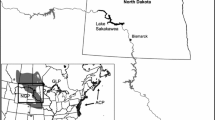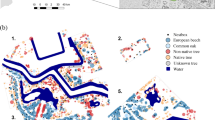Abstract
Intensification of farming over the past 50 years has homogenised the landscape structure and contributed to the decline of bird populations in Europe. To better target the conservation of the Barn Owl Tyto alba, we assessed the influence of the landscape structure on breeding performance in western Switzerland. The analyses considered a 23-year dataset of breeding parameters collected in an area dominated by intensive agriculture. Using a Geographic Information System approach, landscape characteristics were described around 194 nest sites. Our analyses showed that nest-box occupancy, laying date, clutch and brood size, egg volume and probability of producing a second annual clutch were not significantly associated with any of the eight principal landscape variables (agricultural land, woodland, urban area, hedgerows, cereals, sugar beet, maize and meadow). Nevertheless, the probability that a breeding pair occupied a nest-box decreased the more roads there were surrounding the nest-box. The absence of strong associations between habitat features and breeding parameters suggests that prey availability may be relatively similar between the different breeding sites. In our study area, Barn Owls can always find suitable foraging habitats around most nest-boxes.



Similar content being viewed by others
References
Altwegg R, Roulin A, Kestenholz M, Jenni L (2003) Variation and covariation in survival, dispersal, and population size in barn owls Tyto alba. J Anim Ecol 72:391–399
Altwegg R, Roulin A, Kestenholz M, Jenni L (2006) Demographic effects of extreme winter weather in the barn owl. Oecologia 149:44–51
Altwegg R, Schaub M, Roulin A (2007) Age-specific fitness components and their temporal variation in the barn owl. Am Nat 169:47–61
Andries AM, Gulinck H, Herremans M (1994) Spatial modelling of the barn owl Tyto alba habitat using landscape characteristics derived from SPOT data. Ecography 17:278–287
Arlettaz R, Krähenbühl M, Almasi B, Roulin A, Schaub M (2010) Wildflower areas within revitalized agricultural matrices boost small mammal populations but not breeding barn owls. J Ornithol. doi:https://doi.org/10.1007/s10336-009-0485-0
Aschwanden J, Birrer S, Jenni L (2005) Are ecological compensation areas attractive hunting sites for common kestrels (Falco tinnunculus) and long-eared owls (Asio otus)? J Ornithol 146:279–286
Aschwanden J, Holzgang O, Jenni L (2007) Importance of ecological compensation areas for small mammals in intensively farmed areas. Wildl Biol 13:150–158
Atkinson PW, Fuller RJ, Vickery JA, Conway GJ, Tallowin JRB, Smith REN, Haysom KA, Ings TC, Asteraki EJ, Brown VK (2005) Influence of agricultural management, sward structure and food resources on grassland field use by birds in lowland England. J Appl Ecol 42:932–942
Avenant NL (2005) barn owl pellets: a useful tool for monitoring small mammals communities? Belg J Zool 135:39–43
Benton TG, Vickery JA, Wilson JD (2003) Farmland biodiversity: is habitat heterogeneity the key? Trends Ecol Evol 18:182–188
Billeter R, Liira J, Bailey D, Bugter R, Arens P, Augenstein I, Aviron S et al (2008) Indicators for biodiversity in agricultural landscapes: a pan-European study. J Appl Ecol 45:141–150
Bond G, Burnside NG, Metcalfe DJ, Scott DM, Blamire J (2005) The effects of land-use and landscape structure on barn owl (Tyto alba) breeding success in southern England, UK. Landscape Ecol 20:555–566
Bontzorlos VA, Peris SJ, Vlachos CG, Bakaloudis DE (2005) The diet of barn owl in the agricultural landscapes of central Greece. Folia Zool 54:99–110
Butet A, Paillat G, Delettre Y (2006) Factors driving small rodents assemblages from field boundaries in agricultural landscapes of western France. Landscape Ecol 21:449–461
Chaline J, Baudvin H, Jammot D, Saint Girons MC (1974) Les proies des rapaces (petits mammifères et leur environnement). Doin, Paris
De Bruijn O (1994) Population ecology and conservation of the barn owl Tyto alba in farmland habitats in Liemers and Achterhoek (The Netherlands). Ardea 82:1–109
de la Pena NM, Butet A, Delettre Y, Paillat G, Morant P, Le Du L, Burel F (2003) Response of the small mammal community to changes in western French agricultural landscapes. Landscape Ecol 18:265–278
Donald PF, Green RE, Heath MF (2001) Agricultural intensification and the collapse of Europe’s farmland bird populations. Proc R Soc Lond B 268:25–29
Durant JM, Gendner JP, Handrich Y (2004) Should I brood or should I hunt: a female barn owl’s dilemma. Can J Zool 82:1011–1016
Erritzoe J, Mazgajski TD, Rejt L (2003) Bird casualties on European roads-a review. Acta Ornithol 38:77–93
Garcia-Ripolles C, Lopez-Lopez P, Garcia-Lopez F, Aguilar JM, Verdejo J (2005) Modelling nesting habitat preferences of Eurasian griffon vulture Gyps fulvus in eastern Iberian Peninsula. Ardeola 52:287–304
Horváth G, Dániel M, Tamás N, Sándor C (2005) Landscape ecological analysis of barn owl pellet data from the Drava lowlands, Hungary. Natura Somogyiensis 7:179–189
Kasprzykowski Z, Golawski A (2006) Habitat use of the barn owl Tyto alba and the little owl Athene noctua in central-eastern Poland. Biol Lett 43:33–39
Keller V, Zbinden N, Schmid H, Volet B (2001) Liste Rouge des oiseaux nicheurs menacés de Suisse. Edit. Office fédéral de l’environnement, des forêts et du paysage, Berne et Station ornithologique suisse, Sempach. OFEFP—Série: L’environnement pratique. p. 57
Klok C, de Roos AM (2007) Effects of vole fluctuations on the population dynamics of the barn owl Tyto alba. Acta Biotheor 55:227–241
Leech DI, Shawyer CR, Barimore CJ, Crick HQP (2009) The barn owl monitoring programme: establishing a protocol to assess temporal and spatial variation in productivity at a national scale. Ardea 97:421–428
Lopez-Lopez P, Garcia-Ripolles C, Aguilar JM, Garcia-Lopez F, Verdejo J (2006) Modelling breeding habitat preferences of Bonelli’s eagle (Hieraatus fasciatus) in relation to topography, disturbance, climate and land use at different spatial scales. J Ornithol 147:97–106
Love RA, Webbon C, Glue DE, Harris S (2000) Changes in the food of British barn owls (Tyto alba) between 1974 and 1997. Mammal Rev 30:107–129
Lundstrom C (2002) Dynamique du paysage rural de la partie nord-ouest de la Suisse. Une analyse pour comprendre la variation des populations du lièvre brun (Lepus europaeus). Ecole Polytechnique Fédérale de Lausanne, Lausanne. 158 pp
Marti CD (1999) Natal and breeding dispersal in barn owls. J Raptor Res 33:181–189
Martinez JA, Zuberogoitia I (2004) Habitat preferences and causes of population decline for barn owls Tyto alba: a multi-scale approach. Ardeola 51:303–317
Maumary L, Vallotton L, Knaus P (2007) Les oiseaux de Suisse. Station ornithologique Suisse, Sempach, et Nos oiseaux, Montmollin
Meek WR, Burman PJ, Nowakowski M, Sparks TH, Hill RA, Swetnam RD, Burman NJ (2009) Habitat does not influence breeding performance in a long-term barn owl Tyto alba study. Bird Study 56:369–380
Michel N, Burel F, Butet A (2006) How does landscape use influence small mammal diversity, abundance and biomass in hedgerow networks of farming landscapes? Acta Oecol 30:11–20
Newton I (2004) The recent declines of farmland bird populations in Britain: an appraisal of causal factors and conservation actions. Ibis 146:579–600
Rodriguez C, Peris SJ (2007) Habitat associations of small mammals in farmed landscapes: implications for agri-environmental schemes. Anim Biol 57:301–314
Roulin A (2002a) Tyto alba barn owl. BWP 4:115–138
Roulin A (2002b) Offspring desertion by double-brooded female barn owls Tyto alba. Auk 119:515–519
Roulin A (2004a) The function of food stores in bird nests: observations and experiments in the barn owl Tyto alba. Ardea 92:69–78
Roulin A (2004b) Covariation between plumage colour polymorphism and diet in the barn owl Tyto alba. Ibis 146:509–517
Salvati L, Ranazzi L, Manganaro A (2002) Habitat preferences, breeding success and diet of the barn owl (Tyto alba) in Rome: urban versus rural territories. J Raptor Res 36:224–228
Seamans ME, Gutierrez RJ (2007) Habitat selection in a changing environment: the relationship between habitat alteration and spotted owl territory occupancy and breeding dispersal. Condor 109:566–576
Shaw G (1994) A ten year study of barn owl conservation in conifer forests. Scott Birds 17:187–191
SIGMAPLAN/METRON/METEOTEST (2001) Le paysage sous pression: 1984–1995. Office fédéral du développement territorial/Office fédéral de l’environnement, des forêts et du paysage, Berne
Stoate C, Baldi A, Beja P, Boatman ND, Herzon I, van Doorn A, de Snoo GR, Rakosy L, Ramwell C (2009) Ecological impacts of early 21st century agricultural change in Europe—a review. J Environ Manage 91:22–46
Taylor IR (1993) Age and sex determination of barn owls Tyto alba alba. Ring Migr 14:94–102
Taylor IR (1994) barn owls: predator–prey relationships and conservation. Cambridge University Press, Cambridge
Tores M, Motro Y, Motro U, Yom-Tov Y (2005) The barn owl—a selective opportunist predator. Isr J Zool 51:349–360
Tworek S (2002) Different bird strategies and their responses to habitat changes in an agricultural landscape. Ecol Res 17:339–359
Zuberogoitia I (2000) La influencia de los factores meteorologicos sobre el exito reproductor de la lechuza comun. Ardeola 47:49–56
Acknowledgments
We thank Bettina Almasi, the late Martin Epars and Henri Etter for help with collecting field data. We also thank Simon Birrer, Lukas Jenni, Motti Charter, Iñigo Zuberogoitia, Meredith Blake and an anonymous referee for helpful comments on an early version of the manuscript and Pierre Bize for statistical advice. The Swiss National Science Foundation (grants no. PPOA-102913 and 31003A_120517 to A. Roulin) supported this study financially.
Author information
Authors and Affiliations
Corresponding author
Additional information
Communicated by F. Bairlein.
Rights and permissions
About this article
Cite this article
Frey, C., Sonnay, C., Dreiss, A. et al. Habitat, breeding performance, diet and individual age in Swiss Barn Owls (Tyto alba). J Ornithol 152, 279–290 (2011). https://doi.org/10.1007/s10336-010-0579-8
Received:
Revised:
Accepted:
Published:
Issue Date:
DOI: https://doi.org/10.1007/s10336-010-0579-8




